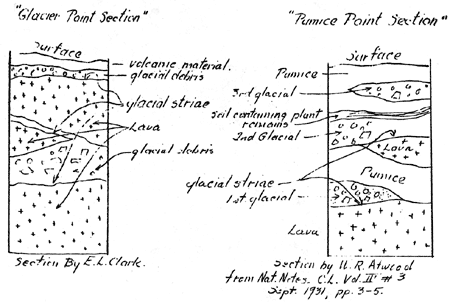|
Volume VI No. 3 - August, 1933
Three Successive Records Of Glaciation
By Ranger-Naturalist E. L. Clark
Along the inner rim slope midway between Sinnott Memorial and
Discovery Point occurs a record of three successive glaciations. There
in the great outdoor laboratory of vulcanism and glaciation are found
three separate layers of glacial drift. The accompanying diagram
illustrates the arrangement of the several glacier evidences. A section
by W. R. Atwood has been included as a means of comparing the evidence
of glaciation found at different localities within the rim of the
crater.
It will be readily seen that the record of glaciation found at
"Glacier Point" is of much significance inasmuch as it represents two
distinct outpourings of lava after the appearance of the first glacier.
The question may be raised; Are the glacial tracks really the marks
made by moving masses of ice or are they pseudo-glacial markings formed
by the solidification of hot, seething masses of lava pouring out of a
volcanic crater and down the mountain side?
Glacial striae are superficial scratches or grooves made on a rock
surface by the tools of a glacier as it slides over the bedrock. These
markings are usually arranged in parallel groups. The direction in
which the striae are running is indicative of the general trend of
movement of the glacier at that particular place. It happens that the
rock surfaces will be somewhat polished and at least smoothed by the
abrasive action of the ice and detritional rock fragments.
Banding due to flowage of the lava is the internal arrangement of
particles within the lava flow. These particles may occur singly or in
combination.

They may be crystals that had started to form before the ejection or
outpouring of the lava from its conduit. They may be included material
that were picked up by the lava as it moved over loose fragments of
other rocks; or they may happen to be certain portions of the lava flow
rich in volatile constituents which on release may leave cavities in the
solidified lava and produce the frequent occurrence of lines or layers
of bubble marks in a lava. One portion of this structure may vary in
its relation to its remainder. Furthermore, one set of flow banding
need not agree in attitude with the other sets of flow banding in a
single lava bed. More often it happens that one flow structure can be
traced to a place in the lava flow where it intersects a second flow
banding. Fracturing of the lava during its cooling may produce smooth
curved surfaces, but these will never be straight and polished as
produced by glacial scour.
One who walks along the path of Nature to Discovery Point shall have
a wonderful opportunity to read the story recorded in the rocks and
distinguish between these confusing structures. Along this trail one
first meets with glacial striae on the upper surfaces of many lava
flows. Next a pseudo-striation produced by both flow banding and
fracturing of the hot molten mass will be noted. And further along the
trail Mother Nature has placed these two confusing structures together.
The glacial striae are seen to be at right angles to the flow banding of
the lava, and again, within the same lava flow, the striae are seen
parallel to the banding. Truly, it is here where Mother Nature has
solved the problem and completed the lesson for the day.
| 
